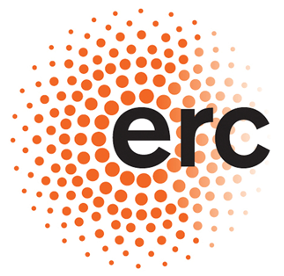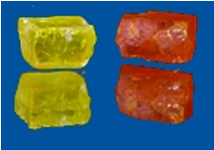- About Us
- Group
- News
- Research
- Publications
- Ongoing Projects
- Contact Details
ERC Starting Grant Revealing the electronic energy landscape of multi-layered optoelectronic devices (ENERGYMAPS)
Modern optoelectronic (OE) devices such as light-emitting or photovoltaic diodes offer exciting opportunities for the future. A wide range of materials has been utilized in these devices, including among others: organic materials, inorganic quantum dots and hybrid perovskites. While the functionality, performance and device physics vary strongly from material to material and device to device, all OE devices depend on the energy levels of their individual components and the interaction of the electronic states at the various heterointerfaces. Lacking a method to map the energy levels in a device, energy level  diagrams reported for most devices consist of a combination of individual energy levels for each material, which neglect interactions between the materials (that may cause interfacial dipoles and/or band bending) and do not represent the true energetic landscape. Despite this, they are routinely used for interpretation of device performance and physics. This project aims to map the energy levels in real functional devices: revealing the true nature of buried interfaces, multilayers and contacts, and to answer fundamental long-standing questions in the field of OE, such as the origin of photovoltage losses and energetics of injection/extraction contacts of devices. We will develop and utilize a “Ultra-violet photoemission spectroscopy (UPS) depth profiling” technique based on the combination of UPS with Ar gas cluster ion beam (GCIB) etching that induces minimal surface damage, on a wide range of organic, inorganic and hybrid materials and devices. We will reveal the true energy level landscapes of devices and monitor their evolution throughout the device lifetime. Furthermore, we will explore the possibility to expand the use of GCIB etching beyond UPS as a new nanofabrication technique. These studies will open new frontiers in OE research and would allow the development of novel interface engineering approaches, device architectures and material design rules.
diagrams reported for most devices consist of a combination of individual energy levels for each material, which neglect interactions between the materials (that may cause interfacial dipoles and/or band bending) and do not represent the true energetic landscape. Despite this, they are routinely used for interpretation of device performance and physics. This project aims to map the energy levels in real functional devices: revealing the true nature of buried interfaces, multilayers and contacts, and to answer fundamental long-standing questions in the field of OE, such as the origin of photovoltage losses and energetics of injection/extraction contacts of devices. We will develop and utilize a “Ultra-violet photoemission spectroscopy (UPS) depth profiling” technique based on the combination of UPS with Ar gas cluster ion beam (GCIB) etching that induces minimal surface damage, on a wide range of organic, inorganic and hybrid materials and devices. We will reveal the true energy level landscapes of devices and monitor their evolution throughout the device lifetime. Furthermore, we will explore the possibility to expand the use of GCIB etching beyond UPS as a new nanofabrication technique. These studies will open new frontiers in OE research and would allow the development of novel interface engineering approaches, device architectures and material design rules.
DFG-ANR joint project Physics of degRadation in Organic, nanoCrystal, and hybrid solar cEllS (PROCES)
Facing the rising energy usage worldwide, we urgently need to increase the proportion of electricity generated from clean and renewable energy sources. Organic, colloidal nanocrystal quantum dots (QDs), and hybrid organic-inorganic perovskites are highly promising solution-processable material candidates for "third-generation" solar cells. Their unique material characteristics can lead to flexible, light-weight, low cost and high-performance solar cells and enable non-conventional solar cell products. While the efficiencies are being improved constantly by intensive research, the Achilles heel of these devices seems to be their environmental instability. So far only limited research has been done to study the fundamental causes and mechanisms leading to the environmental instability in devices based on organic, nanocrystal and hybrid perovskite materials. Developing a clear understanding of the physicochemical processes of degradation would aid the integration of these devices into industrial applications, guiding both material and device engineering to improve device lifetimes. Therefore, in this "PROCES" project we aim to (1) identify the fundamental causes of degradation of organic, inorganic nanocrystal and hybrid organic-inorganic thin films; (2) understand the physical origin of degradation, i.e. the formation of degradation products; (3) correlate the changes in device characteristics to the causes identified; and (4) develop strategies to improve material and device stability. It can be anticipated that through this study we will gain fundamental understanding of how different choices of materials (organic, nanocrystal, or hybrid components), their synthetic and surface chemistry, and different device architectures, impact on the device degradation mechanisms. Understanding these aspects will not only lead to organic, quantum dot and hybrid solar cells with improved device lifetimes, but also offer material and device design guidelines for further optimization of future third-generation photovoltaics. This 3-year ANR-DFG project will be carried out by a tight collaboration between two research teams from the Technical University of Dresden (Germany) and the LPEM (Laboratoire de Physique et d'Etude des Matériaux, a research unit of CNRS/ESPCI-ParisTech/Université Pierre et Marie Curie). The project will build on the strength and expertise of these two teams to allow for a multidisciplinary investigation. The results of this collaborative approach will boost the research capability of each team surpassing its current level and allowing an ideal platform to tackle the complex and multi-domain challenges to maximize the environmental stability in organic, inorganic nanocrystal and hybrid organic-inorganic material systems.
SPP 2196 PERovskite deFECTs: Physics, eVolution and Stability (PERFECT PVs)
The advent of hybrid perovskite solar cells has given rise to extraordinary photovoltaic performance. However, the new physical characteristics of these materials are not yet completely understood, including the role of ionic and electronic defects on the solar cell performance, hysteresis and stability. In this proposal we will explore and characterize the nature of defects in lead halide perovskite thin films and photovoltaic devices, investigate how they influence the long-term stability and explore mitigation strategies for their passivation. We will fabricate both vertical photovoltaic devices and lateral devices from methylammonium lead triiodide and triple cation based perovskites, and tune the defect density in the perovskite active layer by varying the stoichiometry of the precursor solution with high precision in a systematic fashion. The relation of defect states and their properties — type, activation energy, concentration, distribution, surface or bulk, etc. — to the solar cell parameters and degradation will be investigated in view of the fractional changes in stoichiometry. We will apply a complementary combination of experiments, including time-resolved, spatially-resolved and temperature dependent electronic and optical methods to obtain a clear physical picture of the role of defects in perovskite materials. Beyond this fundamental understanding of defect physics, it is our goal to identify the nature of the most prominent defect states in lead halide perovskite solar cells and to pursue strategies for their passivation in order to improve both the performance and the long-term stability of perovskite photovoltaic devices.

Fulbright-Cottrell Award Project
In this project we explore the thermal properties of a range of semiconducting materials using photothermal deflection spectroscopy. Photothermal deflection spectroscopy (PDS) has been developed by Jackson et al in 1981 as an absorption measurement method. Detection of extremely low absorption states is exceptionally difficult using standard transmission measurements, as the electronic noise on conventional detectors and the readout electronics becomes greater that the signal due to the sample absorption. PDS is based on the naturally occurring ‘mirage effect’ and is sometimes referred to as ‘mirage spectroscopy’. PDS uses the heat that is created by the dissipation of energy from the excited state to affect a change in the refractive index of a surrounding medium (typically an inert fluid). This change in refractive index will change the optical path of light passing through the heated region of the medium – the same effect that causes a mirage in a desert, or a road on a hot day. This change can be detected by passing a laser through this region and monitoring the deflection of the output beam. Because the laser beam intensity is constant, the impact of detector noise is greatly reduced. Using lock-in amplification (phase sensitive detection), further improves the accuracy of the PDS technique, allowing detection at least 100 times more sensitive than conventional UV-Vis spectroscopy. A precondition of lock-in amplification is controlled modulation of the signal – hence the pulsing (chopping) of the monochromatic pump light. PDS does not only offer the measurement of the spectral absorption coefficient, but also the determination of the thermal diffusivity of the material under investigation.




